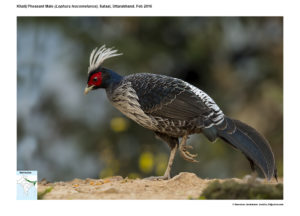
Khalij Pheasant Lophura leucomelanos
Etymology:
- Lophura : Greek word lophoscrest; oura
- Leucomelanos : Greek word leukoswhite; melanos-black
Vernacular Names:Hindi: Kaleej, Kukera, (M) Kalesur, Kala murgha, (F) Kalesi, H.P: Kolsa, Pun: Kulsa, Ass: Dorik, Mathura, Cachar: Deodip, Modura (plains), Durug, Lepcha: Karrhyak, Kuki: Vohtep, Naga: Inruitip, Mani: Waba, Bhutan: Leko, Nepal: Rechabo, B’ desh: Mathura, B’ desh, Meghalaya: Dorik, Dirrik, Burmese: Yit, Rak
Distribution in India: Resident of Himalayas and North East India.
Description: Size of male is 63–74 cm, wt. of male is 795–1150 g; size of female is 50–60 cm, wt. of female is 564–1025 g. The male is amongst the most variable pheasants; mainly blue, with long crest and scarlet face wattles; legs are pale brown, greenish or grey. The female is mostly reddish brown or dark brown with pale markings. The bill is greenish horn and irides are orange-brown. The juvenile is dark brown, but underparts feathers have white spot at tip, while those of upperparts have dark subterminal bar and buff fringe. Considerable variation in male plumage among races, mainly in colour of breast, and extent of white markings on lower back, rump and tail: race hamiltoni has white or very pale crest, broad whitish barring over rump and brownish-white fringes to underparts feathers; race leucomelanos has shorter blackish crest, less extensive pale fringes to underparts and narrower barring on rump ,race melanota is wholly blue-black above and less distinct whitish feather fringes on underparts.
Habitat:It is found in evergreen and deciduous forests with dense undergrowth in valleys to thickets, secondary vegetation and abandoned cultivation. It is found from 25 m to 3700 m.
Food habits: It eats bamboo seeds and small snakes, termites, figs, forest yams and bamboo seeds, acorns, ripe fruits, stems, pods, bulbils and fern tops. They forage in small groups. They usually scratches ground, but can dig for roots and tubers, and may visit tracks and even fields early morning and evening to feed.
Breeding habits: They breed in Mar–Jun (hamiltoni); Apr–Jun (leucomelanos); Mar–May (melanota). The nest is a slight hollow in dense undergrowth, usually near water. They lay a clutch of 6–9 eggs. The incubation period is 20 -22 days, incubation done by female alone. Male tend to the small chicks.